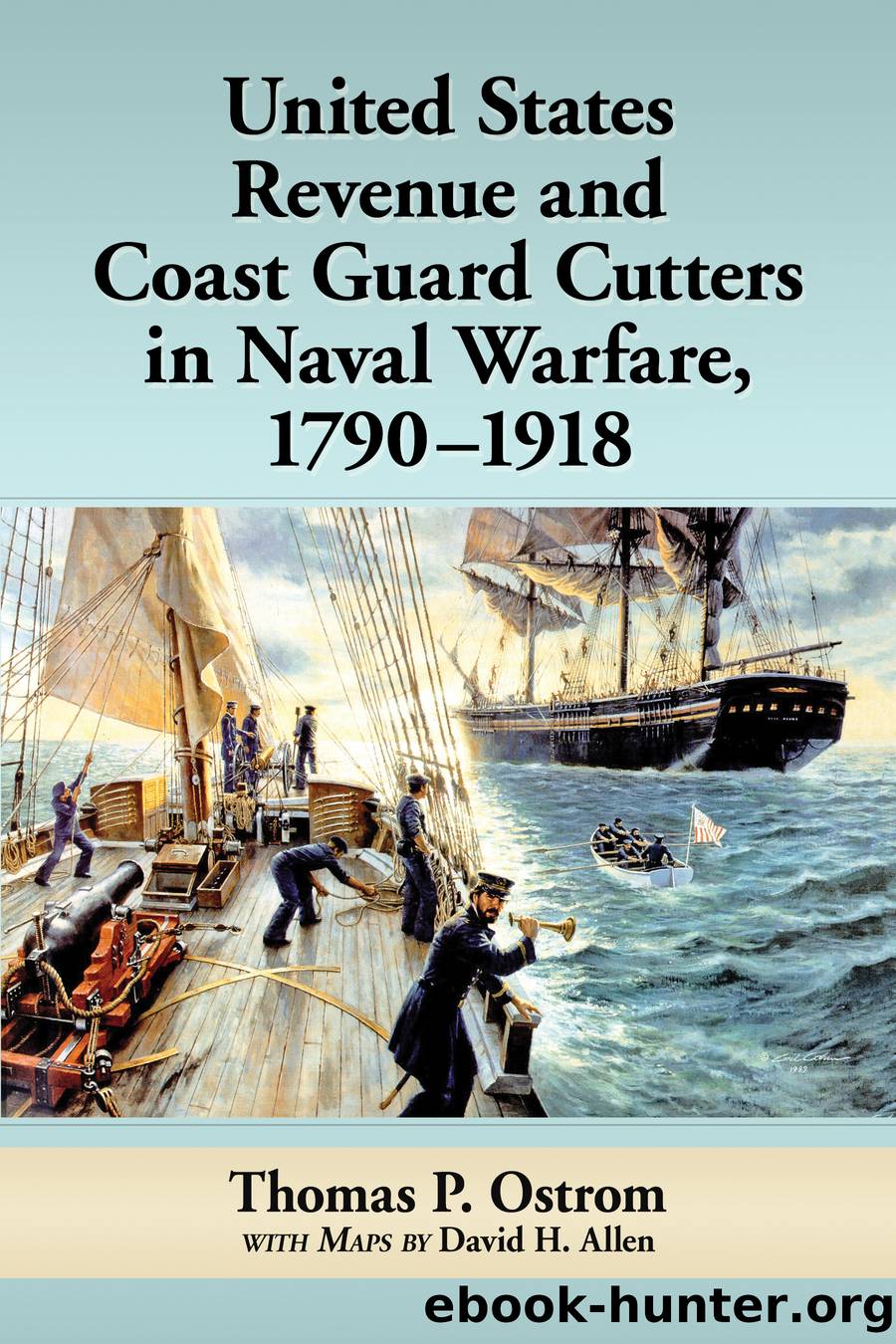United States Revenue and Coast Guard Cutters in Naval Warfare, 1790-1918 by Thomas P. Ostrom

Author:Thomas P. Ostrom
Language: eng
Format: epub
Publisher: McFarland & Company, Inc., Publishers
Published: 2018-01-19T00:00:00+00:00
The 73-foot RC Morris carried six 9-pound guns and a crew complement of twenty. Cuttermen prepare to board the passenger ship Benjamin Adams 200 miles east of New York on 16 July 1861.
Buchanan had served in the U.S. Navy as the first superintendent of the U.S. Naval Academy (1845â1847), fought in the Mexican-American War, was commandant of the Washington Navy Yard, and commanded the USS Susquehanna. Upon joining the CSN in 1861 then Captain Buchanan commanded the iron-hulled monitor CSS Virginia (former USS Merrimack) on 8 March 1862 in the battle at Hampton Roads, Virginia, where the Virginia defeated the wooden ships USS Congress and USS Cumberland. Wounded in that battle, Capt. Buchanan did not command the Virginia the following day in the standoff with the USS Monitor. In 1862 Admiral Buchanan was put in command of the forces at Mobile Bay and assigned to the ram Tennessee. After the Civil War he assumed the presidency of the Maryland Agricultural College (1866) in his home state. He passed away in 1874.13
In 1829 David Dixon Porter joined the Navy. By April 1861 Cmdr. Porter was in command of the USS Powhatan, which patrolled the Gulf of Mexico. In 1862 he led a mortar-boat flotilla under Capt. Farragutâs command in the battle against the Confederate Forts Jackson and St. Philip. In October 1862 Porter assumed command of the Mississippi Squadron, which would finally capture Vicksburg (1863) in a joint operation with the U.S. Army. The victory led to his promotion, and now Rear Admiral Porter was assigned command of the North Atlantic Blockading Squadron. At the end of the Civil War Porter assumed new responsibilities as superintendent of the U.S. Naval Academy and then was appointed the head of the U.S. Navy Department, earning the rank of full admiral in 1870. Admiral Porter crossed the final bar in 1870.14
We now return to the naval battles at Fort Jackson and Fort St. Philip on the Mississippi River in Louisiana (April 18â28, 1862). David D. Porter had been in command of a mortar gunboat flotilla in Captain David Farragutâs armada that moved up river between the forts to capture New Orleans. The forts, one on each bank of the river, possessed heavy artillery batteries and were solidly built with masonry and timber and earthen ridges. A line of sunken hulks and an iron chain blocked the passage of ships. Ten Confederate naval vessels served as the defense fleet of the two forts. Two of the warships (CSS Louisiana and CSS Manassas) were heavily armed ironclads, but inadequate engine power forced the CSS Louisiana to moor and anchor against the shore.
Captain Farragut (USN) had 24 wooden-hull warships under his command. Commander Porter directed 18 mortar schooners, each ship mounting a devastating 13-inch mortar cannon that could shoot a 200-pound shell more than two miles, depending on the angle at which the weapon was set. Farragutâs mobile squadron and dark-of-night maneuvers made difficult targets for the Rebel gunners. The Federals managed to cut the chain and
Download
This site does not store any files on its server. We only index and link to content provided by other sites. Please contact the content providers to delete copyright contents if any and email us, we'll remove relevant links or contents immediately.
Chaco's Northern Prodigies : Salmon, Aztec, and the Ascendancy of the Middle San Juan Region after AD 1100 by Paul F. Reed(355)
Law Enforcement Interpersonal Communication and Conflict Management by Brian Douglas Fitch(347)
Digital International Relations by Unknown(346)
Critical Perspectives on Human Security : Rethinking Emancipation and Power in International Relations by David Chandler; Nik Hynek(329)
Skilled interpersonal communication: Research, theory and practice, Fifth edition by Owen Hargie(327)
The Enduring Color Line in U.S. Athletics by Krystal Beamon Chris M. Messer(325)
Evidence-Based Policy Making in Labor Economics by Hamermesh Daniel S.;Nottmeyer Olga K.;Nottmeyer Olga;King Sarah;King Sarah;King Sarah;(298)
EPSO CAST Political affairs EU policies: How to succeed in the selection procedure by Franco Reverte José María(290)
Writing Public Policy - A Practical Guide to Communicating in the Policy Making Process by Catherine F. Smith(272)
Criminological Theory in Context by John Martyn Chamberlain(269)
Tibeton Yoga Its Secret Doc by Evans-Wentz(267)
Threshold Concepts in Women's and Gender Studies by Christie Launius Holly Hassel(263)
Rothschild and Early Jewish Colonization in Palestine (Geographical Perspectives on the Human Past) by Ran Aaronsohn(263)
Positive Psychology and Spirituality in Counselling and Psychotherapy (Conflict, Ethics, and Spirituality, 12) by unknow(261)
Social Problems, Social Issues, Social Science by James Wright(259)
Play in child development and psychotherapy: toward empirically supported practice by Sandra W. Russ(254)
Cognitive Development in Infancy and Childhood (Elements in Child Development) by Mary Gauvain(252)
Latin American Politics and Society by Gerardo L. Munck & Juan Pablo Luna(224)
What Makes a Social Crisis?: The Societalization of Social Problems by Jeffrey C. Alexander(220)
